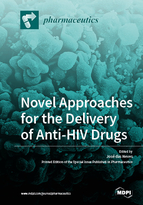Novel Approaches for Delivery of Anti-HIV Drugs
A special issue of Pharmaceutics (ISSN 1999-4923).
Deadline for manuscript submissions: closed (20 February 2019) | Viewed by 48829
Special Issue Editor
Interests: drug delivery; infectious diseases; nanomedicine; nanotechnology; pharmaceutics; women’s health
Special Issues, Collections and Topics in MDPI journals
Special Issue Information
Dear Colleagues,
HIV/AIDS continues to be one of the most challenging individual and public health concerns of our days, affecting roughly 37 million individuals worldwide and killing nearly two million people each year according to the UNAIDS (The Joint United Nations Programme on HIV/AIDS). Investments in the field have been huge but a cure to the infection remains elusive. Nonetheless, tremendous advances have been made over the last 35 years since the HIV-1 was identified, namely in prevention, diagnostics and treatment. The development of antiretroviral drugs and the introduction of highly active antiretroviral therapy (HAART) in the mid-1990s—currently referred to as combination antiretroviral therapy (cART)—led to a dramatic shift of AIDS from a fatal disease into a chronic and often stable medical condition. In fact, cART contributed decisively to a steady decrease in the number of HIV-related deaths since the first years of the new millennium. Antiretroviral drugs have also been found useful in the prevention field, particularly in post-exposure prophylaxis (PEP) or mother-to-child transmission. Treatment as prevention and pre-exposure prophylaxis (PrEP) have further contributed to the reduction of sexually-transmitted HIV infections. Long-lasting injectable products and antiretroviral-based microbicides that are currently in late stages of clinical development or regulatory approval may soon provide new options for prevention. Gene therapy and the use of broadly neutralizing antibodies is also attracting a great deal of interest as possible approaches to HIV/AIDS management.
Still, many challenges remain in anti-HIV drug therapy/prophylaxis and these include, among others: (i) the onset of severe adverse effects leading to discontinuation or interruption of therapy/prophylaxis; (ii) sub-optimal biodistribution and pharmacokinetics, particularly at reservoir sites or mucosae involved in sexual transmission; (iii) the occurrence of viral resistance; (iv) troublesome regimens and/or drug delivery routes that lead to poor adherence by patients/users; (v) low stability and reduced shelf-life of active molecules, which may be particularly challenging in tropical climates and low-resource regions lacking adequate refrigerated distribution channels and storage; (vi) lack of adequate dosage forms for particular populations (e.g. children, women); (vii) costly drug products that are often inaccessible to populations in need of therapy/prophylaxis; and (viii) social and legal constraints resulting in poor access to and discontinuation of anti-HIV therapy/prophylaxis.
This Special Issue of Pharmaceutics intends to focus on new strategies and approaches to the formulation and delivery of anti-HIV drugs (including genetic material and other biopharmaceuticals), which could help solving many of the above identified issues. We welcome articles on all aspects of anti-HIV drug delivery intended at advancing therapy or prophylaxis of HIV/AIDS.
Dr. José das NevesGuest Editor
Manuscript Submission Information
Manuscripts should be submitted online at www.mdpi.com by registering and logging in to this website. Once you are registered, click here to go to the submission form. Manuscripts can be submitted until the deadline. All submissions that pass pre-check are peer-reviewed. Accepted papers will be published continuously in the journal (as soon as accepted) and will be listed together on the special issue website. Research articles, review articles as well as short communications are invited. For planned papers, a title and short abstract (about 100 words) can be sent to the Editorial Office for announcement on this website.
Submitted manuscripts should not have been published previously, nor be under consideration for publication elsewhere (except conference proceedings papers). All manuscripts are thoroughly refereed through a single-blind peer-review process. A guide for authors and other relevant information for submission of manuscripts is available on the Instructions for Authors page. Pharmaceutics is an international peer-reviewed open access monthly journal published by MDPI.
Please visit the Instructions for Authors page before submitting a manuscript. The Article Processing Charge (APC) for publication in this open access journal is 2900 CHF (Swiss Francs). Submitted papers should be well formatted and use good English. Authors may use MDPI's English editing service prior to publication or during author revisions.
Keywords
- Acquired Immunodeficiency Syndrome (AIDS)
- Anti-HIV Agents
- Antiretroviral Drug Delivery
- Broadly Neutralizing Antibodies
- Combination Antiretroviral Therapy (cART)
- Combination Products
- Gene Therapy
- Human Immunodeficiency Virus (HIV)
- Long Acting Injectables
- Microbicide Vaginal Rings
- Mother-To-Child Transmission
- Multipurpose Prevention Technologies
- Nanomedicines
- NeuroAIDS
- Pharmacokinetics
- Post-Exposure Prophylaxis (PEP)
- Pre-Exposure Prophylaxis (PrEP)
- Rectal Microbicides
- Reservoir Sites
- Vaginal Microbicides







